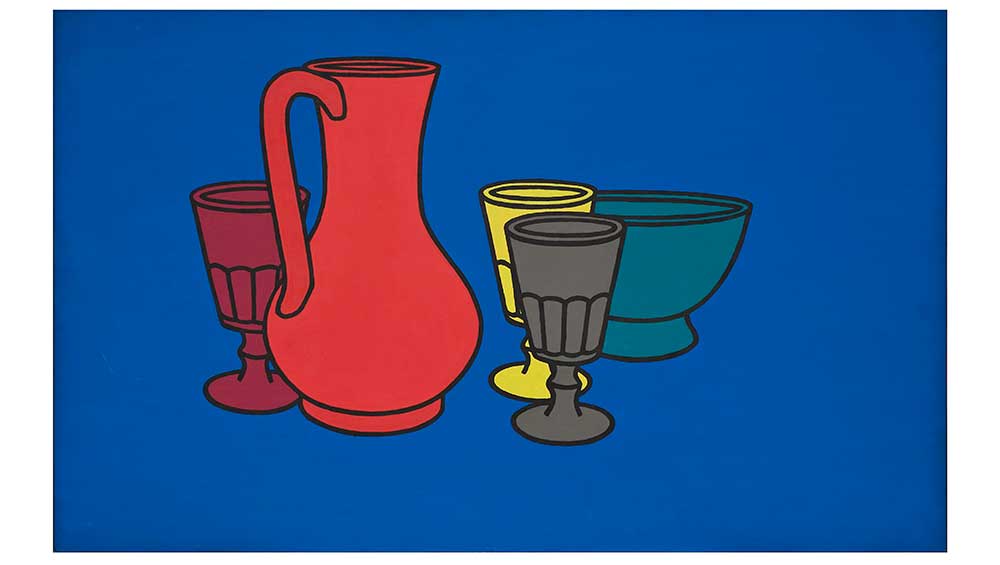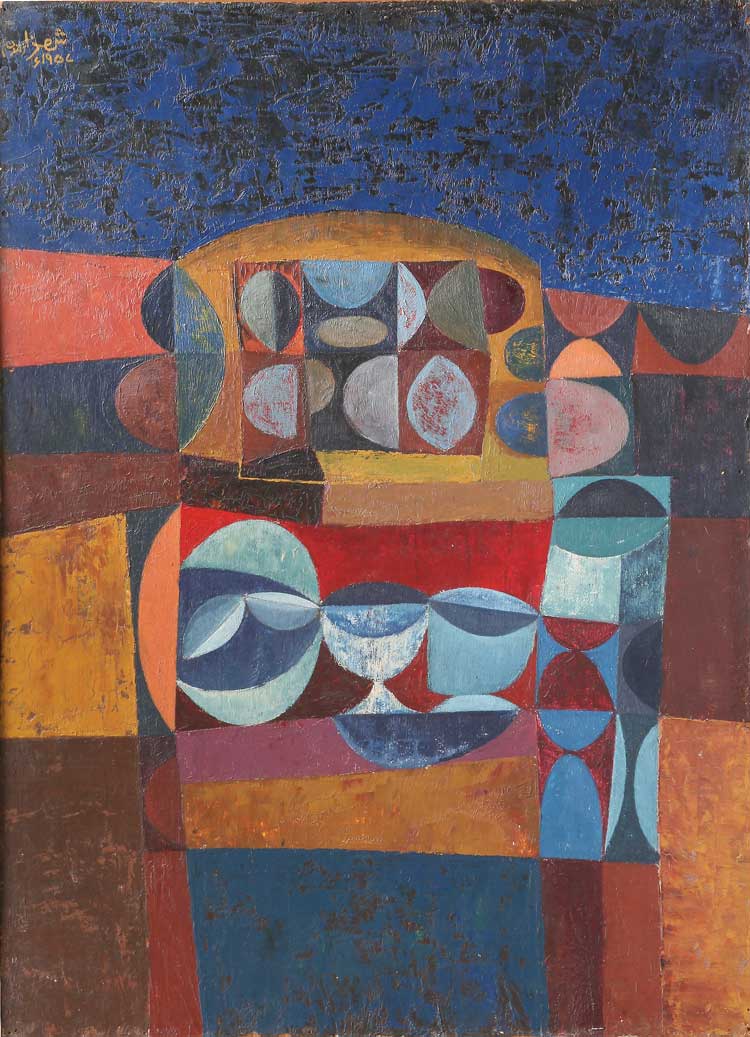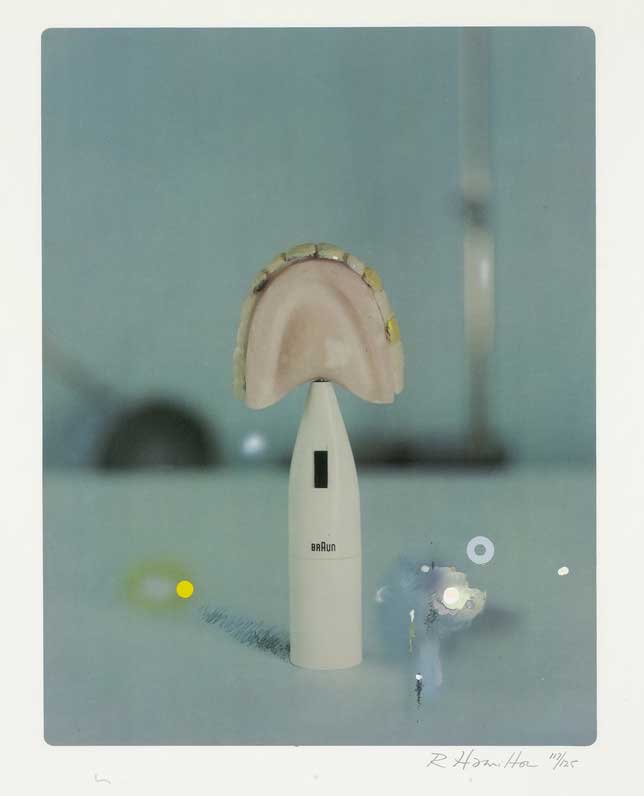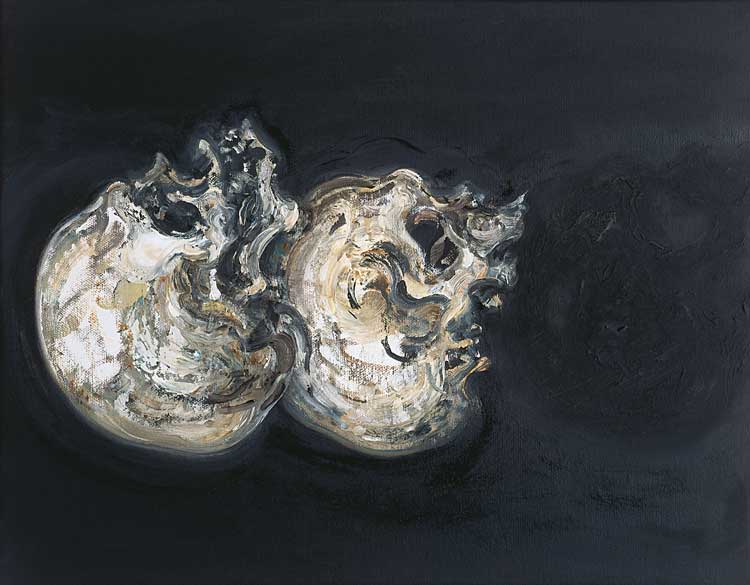
Patrick Caulfield, Coloured Still Life, 1967. Acrylic on panel, accepted in lieu of Inheritance Tax by HM Government from the estate of MJ Long / Wilson and allocated to Pallant House Gallery (2021).
Pallant House Gallery, Chichester
11 May – 20 October 2024
by DAVID TRIGG
“He who produces perfect landscapes is above another who only produces fruit, flowers or seashells,” asserted the French theorist André Félibien in 1667. “He who paints living animals is more estimable than those who only represent dead things without movement,” he continued. Such was the attitude towards still life in the 17th century when, according to the rigid hierarchy of painting categories established by French and British art academies, it was deemed to be the lowliest of genres. In the 20th century, its status was revived by European modernists who followed Paul Cézanne’s radical vocabulary of geometric form and the post-impressionist’s explorations of non-naturalist representation. The possibilities of still life as a vehicle for experimentation stimulated British artists, too, and their enthusiastic embrace of the genre is the subject of this generous and expansive survey at Pallant House Gallery.
_2017.jpg)
Gordon Cheung, Still Life with Goblet (after Pieter de Ring, 1640-69), 2017. Courtesy artist and Cristea Roberts Gallery, London. © Gordon Cheung.
The exhibition opens with a display of historical paintings in dialogue with contemporary works that seem intent on deconstructing the still-life tradition. A luscious 17th-century flower painting by Simon Verelst, who relocated from the Netherlands to London in 1688, is hung next to Toby Ziegler’s Purple Prose (2023), in which lavish blooms painted in the Dutch style have been set upon with an electric sander, creating a play of abstract marks. Nearby, the exquisitely painted books, papers and musical instruments in Edwaert Collier’s Vanitas Still Life (1694) have a solidity that is contrasted by the dissolving feast in Gordon Cheung’s glitchy, computer-generated print Still Life with Golden Goblet (2017), which reimagines a 17th-century composition by the Dutch Golden Age painter Pieter de Ring as a digital abstraction.
-Tate.jpg)
Ben Nicholson, 1943-45 (St Ives, Cornwall), 1943-45. Oil and graphite on canvas, 40.6 × 50.2 cm. Tate: Purchased 1945.
There is humour in Glenn Brown’s Saint Bimbo (2024), a subversion of an early 18th-century vegetable still life by the Florentine painter Bartolomeo Bimbi, in which a turnip (or perhaps a radish) becomes a multilimbed Humpty Dumptyish character, resting precariously on a counter. While Brown gently pokes fun at the past, Ori Gersht uses an air rifle, photographing his violent destruction of carefully crafted replica vessels from the paintings of Giorgio Morandi. The panoramic Evertime 05 (2018), from the artist’s New Orders series, captures a vase exploding into tiny fragments as other broken ceramics topple from the table. For Gersht, the work is intended as a comment on “the fragility and fragmentation of the European Union”.
British still-life artists have long looked to Europe, as evidenced by the chronological portion of the show, which begins with a room of post-impressionist paintings by members and associates of the Bloomsbury Group, the Camden Town Group and the Scottish Colourists. The influence of Cézanne is strongly felt in Spencer Gore’s Still Life with Apples (1912), while John Duncan Fergusson nods to fauvism in The Blue Lamp (1920s), with its brightly coloured fruit bowl and titular lamp. Less interesting works by Roger Fry and Vanessa Bell are balanced by Duncan Grant’s adventurous painting The Mantelpiece, which pushed at the boundaries of still life in 1914 with its heightened colour, semi-abstract brushwork and collaged elements à la Georges Braque.
.jpg)
Edward Wadsworth, Bright Intervals, 1928. Tempera on canvas laid on panel, 63 x 88 cm. Museum & Art Swindon.
With surrealism reaching British shores, painters expanded their repertoire of objects, swapping fresh fruit for startling arrangements of familiar and unfamiliar objects as in Edward Wadsworth’s nautical themed Bright Intervals (1928) and Meredith Frampton’s uncanny Trial and Error (1939), a hyperreal assortment featuring a doll’s head, scrolls of paper, a white carnation in a teapot and a tall urn topped with a pear. For other artists, naturalistic representation gave way to abstraction. Notable examples include Ben Nicholson’s transformation of jugs and cups into fragmented planes of colour and William Scott’s kitchenalia reduced to blue silhouettes and outlines. The language of geometry was explored by Anwar Jalal Shemza, who relocated to Britain from Pakistan in 1957. A painting of his from the same year shows a collection of cups and bowls verging towards the pure abstraction he became known for in the following decade.

Anwar Jalal Shemza, Still Life, 1957. Oil on fibreboard. Estate of Anwar Jalal Shemza.
One of the strongest groupings is titled Death, Decay and Postwar Austerity, which examines the way artists responded to the destruction of the second world war and the existential anxiety that followed (a morbid theme that could sustain an entire exhibition). Memento mori motifs including skulls, dead animals and wilting flowers abound in the darkened space. Standout works include Keith Vaughan’s Still Life with Skull (1952-53), which quotes directly from Cézanne’s 1898 canvas of the same name; its solid lines, strong contrasts and tight focus powerfully reflect Vaughan’s existentialist mindset. Another striking composition is John Craxton’s stark depiction of dead game, Hare on a Table (1944-46), in which the leaping and darting creature is reduced to a lifeless corpse – a metaphor for the artist’s longing to escape the stifling atmosphere of wartime Britain.
The sombre mood gives way to one of celebration in a room dedicated to British pop artists. Here, Peter Blake’s assemblage Love (2007) spells out the titular word in large red letters surrounded by assorted red toys, knick-knacks and bric-a-brac. A witty take on still life is found in Jann Haworth’s fabric sculpture Donuts, Coffee Cups and Comic (1962), in which hand-sewn objects satirise mass-produced consumer goods. In The Critic Laughs (1968), Richard Hamilton presents a Braun electric toothbrush mounted with a set of false teeth; made at a time when critics held more sway, it is another updating of the memento mori but, instead of alluding to human mortality, it is the death of an artist’s reputation in view here.

Richard Hamilton, The Critic Laughs, 1968. Laminated offset lithograph in colours and handcolouring in enamel, on coated stock paper. Wilson Gift through The Art Fund (2006), DACS.
The show closes with a room overflowing with contemporary works, and though some important issues are tackled by individual pieces – sickness, domestic violence, war, climate change, and so on – the absence of an overall theme results in a lack of cohesion. Death remains a consistent thread though, with paintings such as Damien Hirst’s Bognor Blue (2008), comprising eight dead butterflies stuck to a monochrome blue canvas, and Maggi Hambling’s strikingly macabre Cuddling Skulls (1995), a response to her time in Mexico, where she discovered that death was embraced, even celebrated, as a part of life.

Maggi Hambling, Cuddling Skulls, 1995. Oil on canvas, 40 x 50 cm. © The artist.
The French term for “still life” is “nature morte” (literally “dead nature”), yet as this exhibition demonstrates, far from being a moribund genre, it remains full of vitality. According to Pallant House, The Shape of Things is surprisingly “the first major exhibition to consider the subject of still life in modern British art”. On the evidence presented here, it won’t be the last.